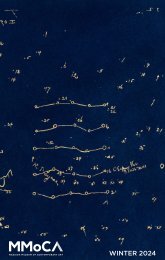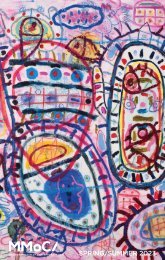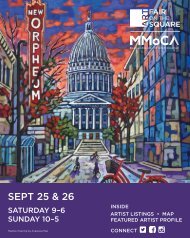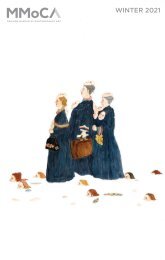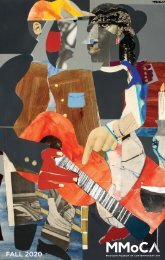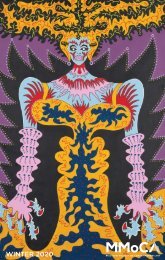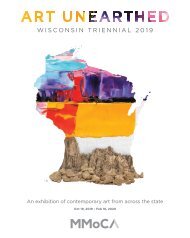Kambui Olujimi: Zulu Time exhibition catalog
This catalog is from the installation of this exhibition at MMoCA. It includes essays by Sampada Aranke, Leah Kolb, and Gregory Volk.
This catalog is from the installation of this exhibition at MMoCA. It includes essays by Sampada Aranke, Leah Kolb, and Gregory Volk.
You also want an ePaper? Increase the reach of your titles
YUMPU automatically turns print PDFs into web optimized ePapers that Google loves.
Above:<br />
Melvin Edwards<br />
Some Bright Morning, 1963<br />
Welded steel<br />
14.5 x 9.3 x 5 inches<br />
(36.83h x 23.62w x 12.7d cm)<br />
Courtesy Alexander Gray<br />
Associates, New York<br />
© 2017 Melvin Edwards/<br />
Artists Rights Society (ARS),<br />
New York<br />
Facing:<br />
Stowaway, from Killing <strong>Time</strong><br />
whose bodies are made temporally present by these cuffs, while nevertheless<br />
absent from their presentation. Put another way, in order to meet their<br />
function, the cuffs necessitate wrists which are themselves made present<br />
here only by their absence.<br />
Killing <strong>Time</strong> activates the suspension of time as mediated through<br />
the prison industrial complex, best understood as the relationship between<br />
prisons, courts, policing, criminalization, and surveillance that anticipates<br />
and exceeds prison walls. The prison industrial complex relies upon<br />
a durational understanding of time, where punishment is determined by<br />
fantastical algebras of equivalence: prison sentences are calculated through<br />
irrational ratios of time, as evidenced by sentences that amount to multiple<br />
lifetimes inside prison walls. “Doing time” becomes shorthand for serving<br />
out one’s sentence, a formula where time is a form of waiting with no<br />
guaranteed endpoint. With Killing <strong>Time</strong>, <strong>Olujimi</strong> takes this logic of time in<br />
a different direction, suggesting that to kill time is to do time, while waiting<br />
to make use of time, while waiting for time to pass.<br />
Further, <strong>Olujimi</strong>’s cuffs and accessories suggest that time is a<br />
practice of relationality mobilized through the proximity to power structures<br />
that make us subjects. However, relationality is by no means overdetermined<br />
by those powers. The blinged-out, decadent objects networked by<br />
10 11






